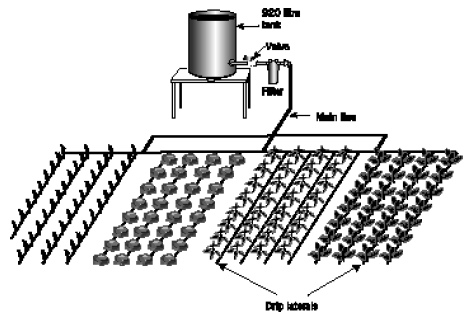Difference between revisions of "Plastro system"
| (7 intermediate revisions by the same user not shown) | |||
| Line 1: | Line 1: | ||
| + | [[Image:drum systems icon.png|right]] | ||
[[Image:plastro gvat.jpg|thumb|right|300px|Layout of Plastro system. Drawing: [http://www.samsamwater.com/library.php?serie=RELMA%20Technical%20Handbook%20Series RELMA.]]] | [[Image:plastro gvat.jpg|thumb|right|300px|Layout of Plastro system. Drawing: [http://www.samsamwater.com/library.php?serie=RELMA%20Technical%20Handbook%20Series RELMA.]]] | ||
| − | The Plastro system was developed in Israel as a low-pressure drip irrigation system with high water efficiency, clogging resistance and durability. For further information contact [ | + | The Plastro system was developed in Israel as a low-pressure drip irrigation system with high water efficiency, clogging resistance and durability. For further information contact [https://www.israelbizreg.com/plastro-gvat-irrigation-industries-ltd Plastro GVAT] in Israel, or ATIF (K) Limited. |
| + | |||
| + | '''Uses of a drum system'''<br> | ||
| + | |||
| + | A drum system covering 5 beds each 1 m wide and 15 m long can be used to grow 250 plants (tomato, egg plant and similar plants requiring a spacing of 60 cm along the plant rows); 500 plants (spinach, cabbage, kale, pepper and similar plants requiring a spacing of 30 cm along the plant rows); or 1,500 plants (onion, carrot and similar plants requiring a spacing of 10 cm). The drum system also offers water storage and control through a control valve, making it possible to fill the drum for irrigating at another time. | ||
| + | |||
| + | Six examples are presented: the KARI drum system from Kenya, the Waggon Wheel system from South Africa, the Family, Plastro and Micro-Tal systems from Israel, and the IDE drum used in India. | ||
| + | |||
| + | ===Construction, operations and maintenance=== | ||
| + | The standard drum kit system comprises a drum, control valve, a manifold and drip lines. The drum should be filled with the valve in the closed position. To irrigate it is important to open the valve fully. This allows the water to be distributed quickly through the drip lines and allows for good water distribution. | ||
| − | |||
'''System components'''<br> | '''System components'''<br> | ||
| Line 16: | Line 25: | ||
* 600 m standard 16 mm drip tube. | * 600 m standard 16 mm drip tube. | ||
| − | ==Reference manuals, videos, links== | + | ===Reference manuals, videos, links=== |
| − | * [ | + | * [https://www.israelbizreg.com/plastro-gvat-irrigation-industries-ltd Plastro Gvat.] |
| + | * [http://rivulis.com/ Rivulis] company. | ||
| − | ==Acknowledgements== | + | ===Acknowledgements=== |
* Sijali, Isaya V. [http://www.samsamwater.com/library.php?serie=RELMA%20Technical%20Handbook%20Series DRIP IRRIGATION: Options for smallholder farmers in eastern and southern Africa.] RELMA, 2001. | * Sijali, Isaya V. [http://www.samsamwater.com/library.php?serie=RELMA%20Technical%20Handbook%20Series DRIP IRRIGATION: Options for smallholder farmers in eastern and southern Africa.] RELMA, 2001. | ||
Latest revision as of 01:49, 20 May 2015

The Plastro system was developed in Israel as a low-pressure drip irrigation system with high water efficiency, clogging resistance and durability. For further information contact Plastro GVAT in Israel, or ATIF (K) Limited.
Uses of a drum system
A drum system covering 5 beds each 1 m wide and 15 m long can be used to grow 250 plants (tomato, egg plant and similar plants requiring a spacing of 60 cm along the plant rows); 500 plants (spinach, cabbage, kale, pepper and similar plants requiring a spacing of 30 cm along the plant rows); or 1,500 plants (onion, carrot and similar plants requiring a spacing of 10 cm). The drum system also offers water storage and control through a control valve, making it possible to fill the drum for irrigating at another time.
Six examples are presented: the KARI drum system from Kenya, the Waggon Wheel system from South Africa, the Family, Plastro and Micro-Tal systems from Israel, and the IDE drum used in India.
Construction, operations and maintenance
The standard drum kit system comprises a drum, control valve, a manifold and drip lines. The drum should be filled with the valve in the closed position. To irrigate it is important to open the valve fully. This allows the water to be distributed quickly through the drip lines and allows for good water distribution.
System components
- 920-litre plastic water tank
- Screen filter (120 mesh)
- Control valve
- 24 m x 32 mm PE pipe
- 2 x 32 mm bends
- 2 x 32 mm equal tees
- 16 dripline start connectors
- 16 dripline end closures
- 600 m standard 16 mm drip tube.
Reference manuals, videos, links
- Plastro Gvat.
- Rivulis company.
Acknowledgements
- Sijali, Isaya V. DRIP IRRIGATION: Options for smallholder farmers in eastern and southern Africa. RELMA, 2001.
